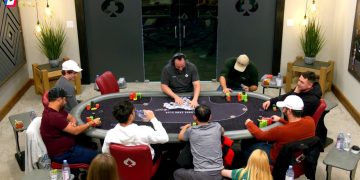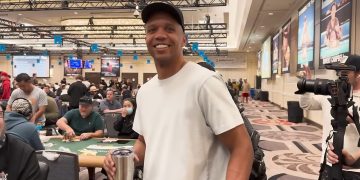What are you doing here? I don’t mean here as in reading this article. The reason you’re probably here for that is because you appreciate reading content by an authors who don’t follow the standard rules, or the standard poker rules.
In fact, when I took an English class in college, I got a C. I remember the final project involved writing about a picture where people were hiding behind a hill. Everyone in the class excluding me either wrote about soldiers or a game of hide-and-seek. I wrote about aliens who were disguised as humans so they could successfully complete their reconnaissance mission. The dude (as in the professor) gave me a D! A D! Believe it or not, this relates to poker strategy.
Connecting an Alien Reconnaissance Mission to Advanced Poker Strategy

I’ll get to the poker strategy aspect soon. I would even consider it advanced poker strategy, but not in the traditional sense.
At that time, I was devastated. When I combined that with someone in my family telling me I had no future because I wanted to be a writer, I felt lost, confused, and disappointed. Those two factors combined also led to a ten-year setback with what I wanted to do. Two important points here.
One, even if it’s the person you love and respect most, if they tell you not to follow your passion, ignore them! This is your life, not theirs. As much as they pretend to hide it, people want what’s best for them, even if they love you. This is more important than poker, and it might also relate to poker.
If it’s the latter, it’s possible to be a winning player, but it requires a lot of discipline on and off the felt. I just want you to know that going in. I’m saying go for it, but establish the right mindset going in.
Two, looking back on that final project now, I’m happy to have written it. What I didn’t know at the time was that the professor was just like everyone else, and 99% of people follow the herd. They prefer to follow because they’re afraid of what might happen if they don’t. They fear being judged.
This happened to me on the poker table. There was a long stretch of time where I was playing by the book and following the herd. I would say to myself: This is what I’m supposed to do here, so it’s what I’ll do. Was that going to make me different? How was I going to have an edge if I played the same as everyone else?
After a one-year break from poker games, I came back with the plan of being me. If that meant limping with AA from the button with five limpers, so be it! The objective was to confuse the hell out of my opponents. It worked to an incredible degree (for me).

On that very first week at the WSOP Circuit at Harrah’s Cherokee, I had four cashes in six Texas Hold’em poker tournaments, with three of them being a final table and one of them being a second final table. I went on to make 15 final tables over the next 10 months, but many of those were Daily and Nightly poker tournaments. The good news is that I won several of these, as well as a winner-take-all poker tournament for a trip to the Caribbean.
My point here is that if you want to win, you need to be you. Don’t play standard. While I’m not an elite poker player, I can promise you that if you play standard, I’m going to know almost all of your poker hands. I don’t think that’s what you want.
I’m not saying to veer too far from standard. Actually, ABC poker strategy can get you deep in many Texas Hold’em poker tournaments, especially Daily and Nightly events. But if you want to actually win those poker tournaments and go deeper in the bigger events, then you need to use a more advanced poker strategy. In this case, I’m not referring to GTO, understanding bluff equity, reverse implied odds, and all of that. I’m referring to reading your opponents.
My two greatest strengths at the poker table are patience and reading my opponents (long-game deception is a close third). The reading ability comes from understanding people. That comes from needing to understanding people in my past in order to survive. Long story there, and it’s not a good fit for a poker article. All I’ll say is that bad isn’t always bad. It might be planting the seed for something good in the future.
If you put two and two together, then you know the advanced poker strategy I’m going to write about leads to what to do when facing a tough decision on the river. I will drop a few poker tips related to this type of situation.
What to Do with Mike
Meet Mike, the player in Seat 1. Mike is wearing a Fitness Connection shirt. You noticed earlier that the word ‘Trainer’ was on the back of the shirt. Mike is about 40 years old with a shaved head (or bald), a clear complexion, and a friendly demeanor. If you look closer, you would notice his bottom row of teeth are crooked. If you listened a little more carefully, you would hear that he lives in an apartment with his girlfriend and two kids.
Mike raised 4x the big blind pre-flop, bet half the pot on the flop, bet 3/4 of the pot on the turn, and went all-in on the river.
Here’s the funny thing about advanced poker strategy. If you’re really playing at the next level, then you don’t even need to know the cards. I didn’t tell you Mike’s position, his physical actions, or how anyone else in the hand acted, yet you still know the answer: Fold.
Trusting Your Gut

You almost always know the answer. There will be times when you’re tricked, but those times are a lot less common than when you’re correct. I would say it’s about 90/10. So, if your gut is correct 90% of the time, don’t worry about the other 10%. Those times are going to happen, but it’s okay.
Trusting your gut is so important. Do you know when you get that inside feeling (more like in your chest) where you know you’re ahead? That’s a relatively strong feeling. But that feeling of impending doom if you call is much stronger. It’s in your chest and upper stomach. You know you’re going to lose if you call, but you sometimes call anyway.
You do this because you’re not trusting yourself! This might seem like basic poker strategy, but it’s the most advanced poker strategy you’re ever going to read when it comes to winning vs. losing.
If you can eliminate those calls, you’re going to turn into a winning poker player. It’s that simple. Think of it this way. Think back to all those poker hands when you called despite that gut feeling of impending doom. What percentage of the time were you correct?
If I had to guess, it would be 10%-15% of the time. Imagine reversing those poker hands to folds. You would have been correct 85%-90% of the time. Do you have any idea how many chips you would have saved total? Do you have any idea how many times you would have had winning sessions in traditional poker games and gone deeper in poker tournaments? Shoot, you might have even had a pet tiger by now. Okay. No pet tiger, but you get the point.
What to Do With Placinda
If I used a regular name like Stacy, then you wouldn’t remember this as well. You will always remember Placinda, even though that’s a Romanian pastry filled with apples or cheese.
Placinda just raised 3x the big blind from middle position. You’re on the button and look down at Jc Tc. One of my favorite hands. You call (it has nothing to do with me). Everyone else folds.
Flop: 8c Ah Js
Meh.
Placinda bets 3/4 of the pot. What do you do? If you answered, “You need to tell me about Placinda, other than her being a Romanian pastry filled with apples or cheese,” then you would be correct. Well played! That right there is the advanced poker strategy I’m talking about. You need to know your opponent before making a decision.
Placinda is a risk-taker. She’s not quite a maniac, but she will gamble. She’s wearing a lot of jewelry, including three necklaces and gold rings on every single finger. Her blue eyeshadow can be distracting, but you try not to look.
You call her flop bet, which is the correct decision. The following might not be one of the most important poker tips I’ve written, but it definitely has value. When you’re up against a LAG player heads-up and they bet the flop when you hit middle pair, it’s almost always a call, especially if you’re in position. You’re not always calling because you think you have the best hand. You’re calling to see if your call slows them down on the turn, which would open the door for you.
Turn: 3h
Placinda pauses, then checks. The door has been opened. You bet 3/4 of the pot. To your surprise, Placinda calls.
River: 2d
Placinda does exactly what Mike did. She goes all-in on the river. We know that Placinda doesn’t have a straight or a flush. Those possibilities are eliminated. Since I just wrote the word ‘eliminated,’ it made me think of an important point. The process of elimination in regards to your opponent’s poker hands is arguably the most effective advanced poker strategy.
She raised pre-flop from middle position. Therefore, the only real possibilities from a pre-flop perspective are a big ace, AJ, or T9. It’s not likely she has AA, JJ, or 88 here. If she had AA or JJ, she would have raised more than 3x the big blind from middle position because that’s too small of a raise to isolate with that many players behind her. I’m not telling you how I think; I’m telling you how other people think.
It’s not likely to be JJ because she wouldn’t have bet 3/4 of the pot on the flop. That’s too big because she wouldn’t want to scare you away. The same can be said for 88. The only real threat is AJ. It’s not likely to be AK, AQ, or AT because she checked the turn. Some pros will do this in this spot, but not often with two potential draws out there. That would be a bad idea on their part.
Even if she has AJ, she wouldn’t like the turn card because it creates a flush draw. It’s possible she knows that you wouldn’t have called the flop with a backdoor flush draw, but the straight draw is still there. This makes AJ less likely.
After going through all the possibilities, you’re not 100% sure, but you’re leaning toward a call. The one determining factor in your decision is Placinda’s character and playing style. If this was a TAG (Tight-Aggressive) player, you would definitely lean toward a fold. A TAG player would rarely go all-in with air in this spot. Since Placinda is a risk-taker, and since the story doesn’t add up, you call.
She says those words you always love to hear after a tough call. Says, “Good call,” as she tables Ts 9s. She was the one with the straight draw.
It was tough to read that hand because she raised 3x the big blind, but if you look back on it, she wanted to put in a standard raise to build a pot in case she hit. All her other actions throughout the hand now make sense: bet the draw on the flop, check the turn, jam the river after a miss. Good call.
The procession of elimination is a key advanced poker strategy. Once you get used to it, all the possibilities will run through your mind like second nature. That’s only when you’re on, though. When you’re off, everything moves a little faster. It’s kind of where I am right now, but I’ve been here before, and I just need to be patient.
Another key advanced poker strategy is to base your decision on your opponent’s character and playing style. You won’t always be correct, but if you lean toward fold against the tight players and call vs. the loose players, you will win more than you lose.
Final Thoughts
We took an interesting path on this one, but ‘interesting’ is the keyword. If this was straightforward and technical advanced poker strategy information, would you still be reading? Nope! Though it might not seem like it, this is one of the most important articles I have written. Whether you choose to review it or not, definitely remember it. It goes toward the top of our list for poker rules for winning. See you at the WSOP!
♠ pokerjournal.org


















Discussion about this post